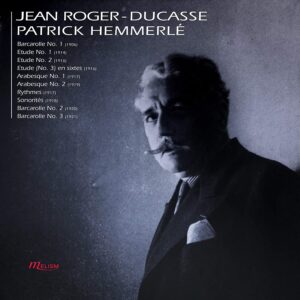The piano music of Jean Roger-Ducasse (1873-1954) is cut from the same subtle and refined cloth as that of his teacher and mentor Fauré, particularly in the latter’s elusive late works. Its difficulties lie not so much with virtuosic challenges as they do with issues of numerous expressive directives and clarifying contrapuntal movement.
It must be said that the titles are deceptive. Don’t expect the two Arabesques to resemble Debussy’s sylph-like creations. The first one, for example, begins with a simple melody cloaked by billowy chromatic movement. As the music unfolds, the piano writing grows thicker and fuller-bodied. Sounds more like a “Ballade” than an “Arabesque”, eh? The Etudes are etudes in the sense that they focus on specific technical issues, yet if Roger-Ducasse had titled them “Nocturnes” we’d be none the wiser. And what of the Sonorités in A-flat major, with its mercurial nature and scintillating sequences? That’s a Capriccio if there ever was one!
More importantly, though, Roger-Ducasse’s exquisite piano writing digs deeply and grows on you over repeated hearings. In 2015 Nimbus brought out Roger-Ducasse’s complete piano works played by Martin Jones in a three-CD set. A fine 2017 Roger-Ducasse release recital for the Grand Piano label featured the late pianist Joel Hastings. While these easily merit recommendation, I now lean toward Patrick Hemmerlé’s masterful interpretations; they command the edge insofar as textural transparency and control are concerned.
For instance, Hemmerlé avoids breaking tempo in the Third Barcarolle’s climaxes and keeps both the busy filigree and melodies supported by large chords in steady perspective. He also shapes the G-sharp minor Etude’s soft and persistent rotary figurations more lightly and evenly than Jones manages, along with a wider palette of tone color, despite slight sonic congestion in loud passages. This repertoire cries out to be discovered, disseminated, and adored.
































